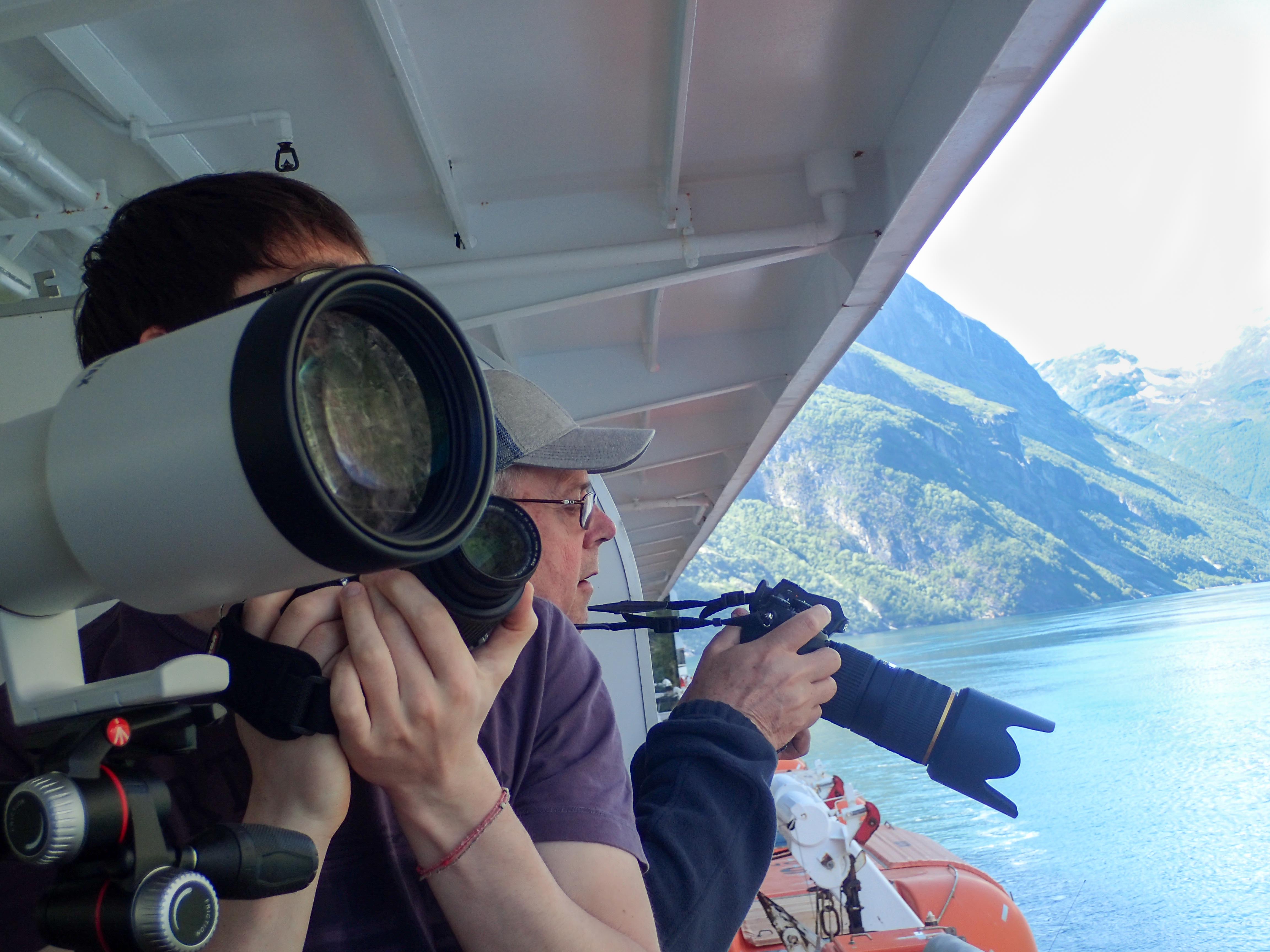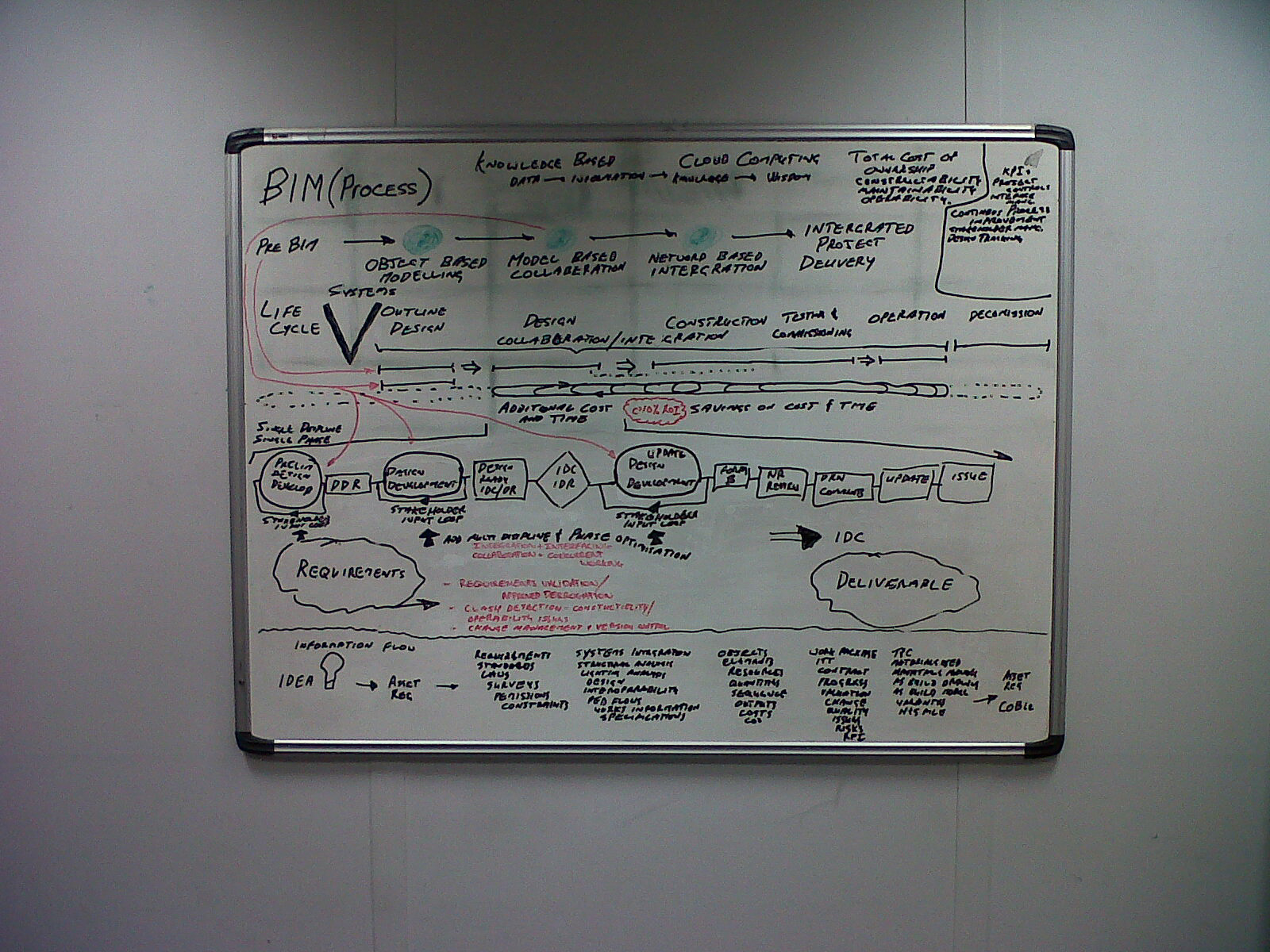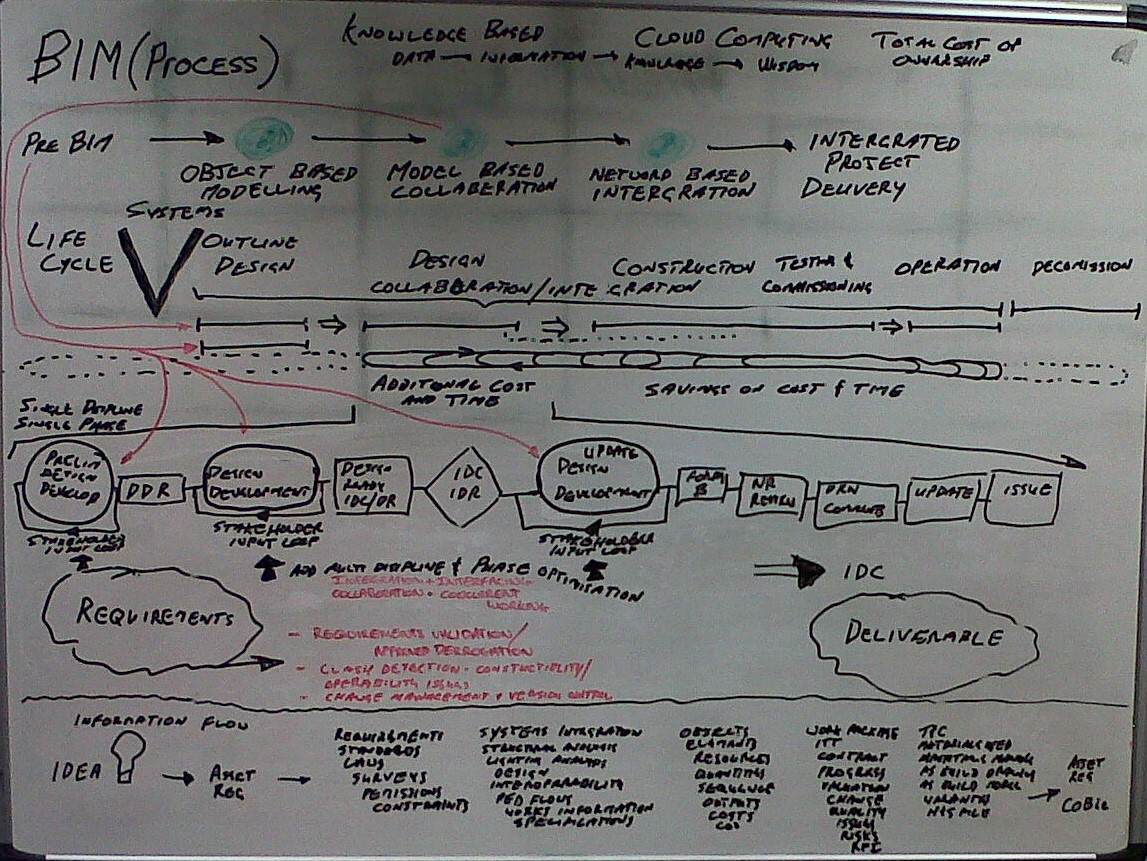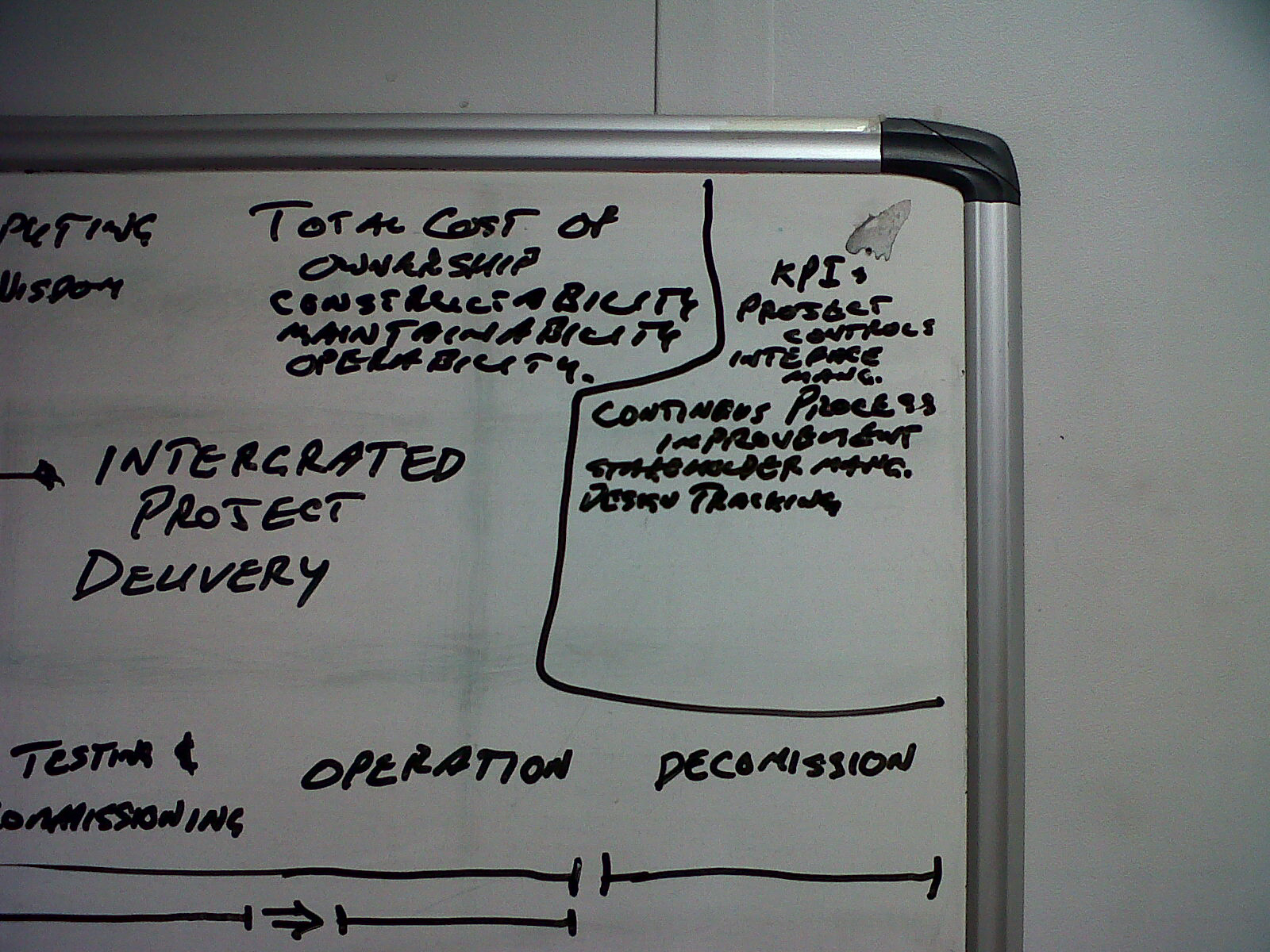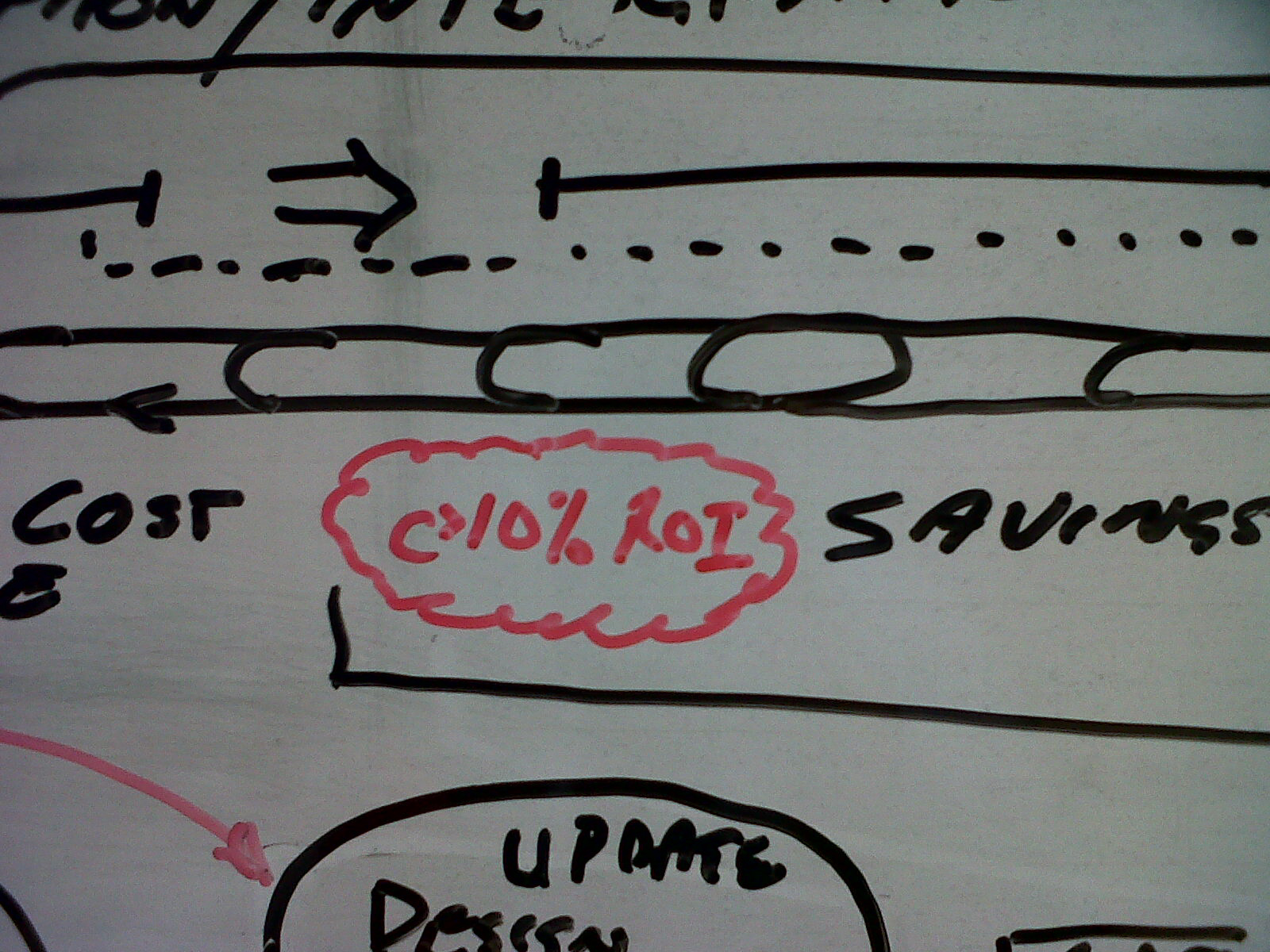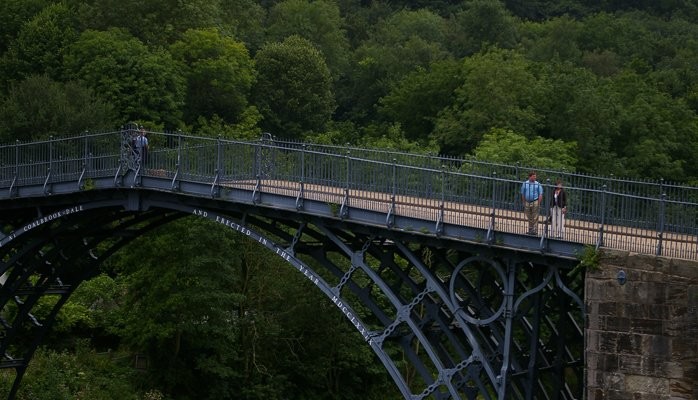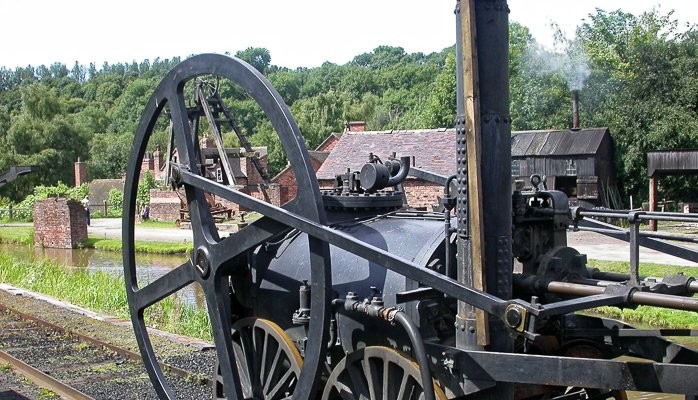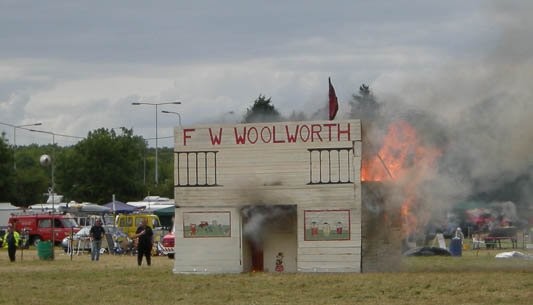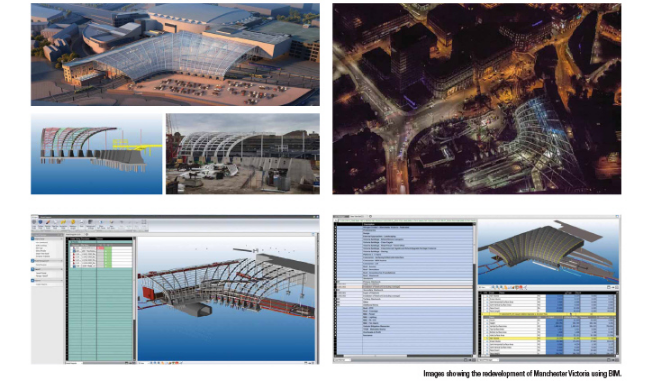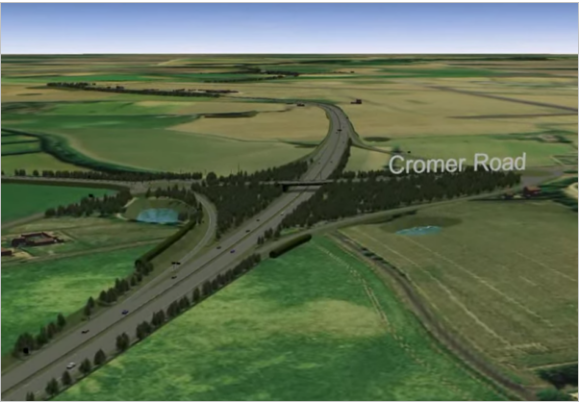Published in three parts in the Civil Engineering Surveyor, the Journal of the Chartered Institution of Civil Engineering Surveyors
Part 1 - November 2012
http://mag.digitalpc.co.uk/fvx/ces/1211/?pn=18 (Link no longer active)
https://www.linkedin.com/posts/ivanhurst_civil-engineering-surveyor-november-2012-activity-5980656766600437760-Z_vc?utm_source=share&utm_medium=member_desktop
Part 2 - January 2013
http://mag.digitalpc.co.uk/fvx/ces/1301/?pn=38 (Link no longer active)
https://www.linkedin.com/posts/ivanhurst_civil-engineering-surveyor-january-2013-activity-5980657188195094528-UIk2?utm_source=share&utm_medium=member_desktop
Part 3 - February 2013
http://mag.digitalpc.co.uk/fvx/ces/1302/?pn=20 (Link no longer active)
https://www.linkedin.com/posts/ivanhurst_civil-engineering-surveyor-february-2013-activity-5980657468101980161-Yn24?utm_source=share&utm_medium=member_desktop
Information Flow, Management and Modelling
Is BIM bigger than Latham?
Introduction
This is a discussion paper about Information Flow, Management and Modelling. Information Flow, Management and Modelling (IFMaM) {IFMM is already taken} is an extension of the concept of Building Information Modelling (BIM). The best thing about BIM is that is a pronounceable, single syllable, TLA. (Three letter acronym). After that it goes downhill. It is not just about Buildings, nor is it just about the 3D model. It is however about Information, the flow of information to and from all of the stakeholders and throughout the lifecycle of the asset. Note that it is not just the lifecycle of the project. The information also has to be managed, which includes stored, disseminated, retrieved, collated, compared, searched, and achieved, to name a few. The nD model is also key to the whole. An nD model? A computer model not limited to 3D, or 4D plus time, or 5D plus cost, or plus carbon, or all of the other current and potential additions. Accordingly this article is not just about BIM but Information Flow, Management, and Modelling.
Primary Consideration
Let us consider what we want to do. Taking a holistic view and going right back to basics; we want a ‘whatsit’ to ‘do something’. If we consider the ‘whatsit’ to be some form of asset, something physical, that can be owned, maintained, and disposed of or replaced, it will make this concept easier to comprehend. Similarly, if we consider the ‘do something’ is to provide a primary function, such as make a profit, ensure health and safety, or to provide a social service. There are many non-profit reasons for the provision of a primary function; however, it is probably easiest and clearest to talk about ‘profit’ and accept that it is generally applicable to the whole.
So, we want to own an asset to make a profit. {Note; asset to make a profit not own an asset and make a profit. (Profit is not an incidental)}
That asset will have a lifecycle which will start at conception, work though feasibility, design, manufacture / construction, operation, maintenance, replacement, and ultimately disposal. This lifecycle is of indeterminate length. An example could be some of the railway branch lines that have closed, where the lifecycle of the asset was in excess of one hundred years. However, it could be argued that even this example is on-going as some of the redundant stations are still used as homes, the engine sheds as workshops, and the track as roads and paths. Putting that aside, the asset has a journey through time that has a beginning, middle, and end, just like a life.
What is the size of the asset? Well, it could be a washer, an insulation pad between rail and sleeper, a railway station or the whole railway network. The whole railway network is obviously more complex than a single component part, but both need management. And to be able to manage you need information. I will have a tendency to use railway examples but it is not restricted to railway any more than BIM is restricted to Buildings. It also applies to an Airbus, a car, a nuclear power station, and the list goes on.
On to profit
Profit can be made by many parties alone the lifecycle of a project. The designer can make a profit in the design, the contractor may make a profit in construction, but ultimately, to provide its primary function, the asset has to make a profit for the asset owner over the lifecycle of the asset.
Let us look at an example of a hypothetical nuclear power station. The United Kingdom's first commercial nuclear power reactor began operating in 1956. There would have been high startup costs of research, design and construction. After that, operation and the production of electricity would have been relatively cheap. On a non-treasury based model, the electricity cost per unit would have to include an element of the startup costs so as to recoup those costs and eventually make a profit, after consideration of finance charges and the like. If that level of income was compared to operational costs, the profit would have perhaps appeared excessive. However, that is not the whole extent of the story, the nuclear waste has to be stored and the power station decommissioned. The huge cost of this wipes out all of the profit made in the half century of operation if the profitability level was based on operational costs. I don’t have any facts to make this pretend example an assertion but it demonstrates the necessity of taking whole life costs into consideration, both when considering the business case of an asset and assessing its profitability during the course of its lifecycle.
It is therefore evident that it should not necessarily be expected for an asset to make a profit during all the stages of the asset lifecycle but it is a prerequisite that the asset makes a profit when the whole lifecycle is taken into consideration. Conceptually, this could include only moving into profit upon disposal, provided always, that all of the financing and other incidental costs are included in the equation.
So where have we got to? We understand that an asset can be pretty much any physical thing. (not going to try to deal with non-physical things here, far too difficult). We also understand that the profit we are considering is that of the asset owner, and has to be considered over the whole life of the asset.
Where next?
We have a desire to own an asset to make a profit. Let us consider something relatively simple, a wheel. What is its main function? I would suggest, to aid the movement of an object. Is the wheel part of a set? Does it have bearings for an axel stub? Is it solid or does it have spokes? How many spokes. Does it have a tyre? Is that tyre rubber or steel. If rubber, is it pneumatic or solid? Does it have to look pretty? Function over form. Again, just a few examples. However, it illustrates that you have to have a mix of Systems Engineering, Requirements Management, and Value Management before you even know what your asset is. Then you have to have somebody design the wheel for you. You tell the designer you want to have something to aid the movement of an object, and you get a selection of logs. Not what you wanted? Perhaps the information flow was wrong. You provide more information and you get closer to what you envisaged.
Systems Engineering, Requirements Management, Risk Management and Value Management
Continuing with the example of the wheel. If you add to its function, that it is a railway power wheel, i.e. its end use, you have added a complication, but again improved the probability that the designer will provide you something useful. On first inspection the wheel can be solid with a steel tyre. However, reviewing the adjacent equipment will identify that there are brakes behind the wheel which would benefit from cooling, and a stub axel as part of the powered bogie which identifies the need for specific form of bearings. Looking at the whole system will inevitable provide a better, more integrated design solution than isolated bits of kit being thrown together. This is where the Systems Engineering comes in. Extend the scope of consideration further, beyond the wheel and the locomotive /powered carriage, and un-sprung weight becomes part of the issue of the wheel / rail interface. The ‘system’ has suddenly got much larger.
Any component has to be designed with due regard for the system within which it will sit and operate. Much as the design will evolve as it progresses through the stages of ‘outline’ to ‘approved for construction’ or manufacture so will the Systems Engineering.
The element of the requirements that describe the asset, its function and use will remain static. The finished design can be checked against the initial requirements. Other elements can be added, such as type, number, and size of ventilation holes, as the design progresses, and used to confirm that the asset has been manufactured both to the asset owner’s function and end use requirements, and the designer’s requirements.
Risk Management is also a key element. What is the probability of a flat tyre and what will be the probable impact. Well, surprisingly, even steel tyres get flats, which can cause broken rails, which in turn causes a failure of the signalling system.
Value Management also comes in to play. If the wheel is for a high cost, high performance car, does the value = function ÷ cost equation justify the use of mag alloy wheels? The Institute of Value Management web site states; ‘The aim of Value Management is to reconcile all stakeholders’ views and to achieve the best balance between satisfied needs and resources.’ …
So where have we got to now? We understand about the asset and profit. We also understand the need to think of the whole system within which the asset will operate; the need for having requirements established and clearly recorded and communicate; and the benefit of risk and value management.
Stages of Asset Lifecycle
We also have the issue of the different stages of the lifecycle of the asset and the different perspective of the stakeholders in those stages. This can include a single stakeholder (perhaps the owner) having different views (excited during feasibility, concerned during construction, and disinterested during decommissioning) or the construction contractor having a narrow, single stage perspective.
It does not particularly matter if we refer to RIBA stages, GRIP stages, or any other stage sequence for this discussion, as the outcome applies equally to them all. Suffice to say there are the following core stages in the lifecycle of most physical assets;
- Early stage, incorporating conception, pre-feasibility, feasibility.
- Design stage, incorporating, research, outline design, detailed design, and approved for manufacture / construction
- Manufacture / Construction; Often considered as ‘the Project.’
- Operation, including maintenance and renewals
- Disposal, including demolition, de-commissioning, return to original state and abandonment.
Even before we have got to BIM we have the perennial and difficult issue of information flow, communication and a multitude of stakeholders. How can all the dispirit people, with not always the same goal, produce, operate and dispose of the asset? Should we give up now and accept that there is such a small probability of success that we would be mad to even think about starting. No, of course not, we will add 50% contingency, cost and time, and get on with it. It will work out in the end. It might even make a profit!
Early stage information flow
Remembering that we want an asset, with which we can make a profit, but let us change from a simple wheel to a railway station. It is a new station, for ease of the example. However, the rail network is already in place. We need all of the information about the existing network. We need to control and record the transfer of that information and disseminate to the right people. Who are the right people? Stakeholder Management comes to mind. Not only do we need to manage the information flow with software and registers we need to manage the way people interface. This also involves reviewing the roles and responsibilities of not just individual people but the disciplines as well. What should the hierarchy of all of the stakeholders be? We have now been provided with all of the information available, allegedly. How do we know if it is in fact all of the information available, or if it is sufficient. In all probability only people involved in the latter stages of the lifecycle will be in a position to answer this. So, despite being at the early stage, and even just in terms of information, we need to engage with other stakeholders, perhaps in the operations stage.
Let me offer the following scenario to you, which is exacerbated with current procurement tendencies.
- A group of people have an idea.
- That group of people give their idea to another group that test the feasibility.
- A consultant is procured to create an outline design. The concept and information previously gathered is thrown over a metaphorical wall in a contractual package. No conferring allowed.
This throwing over wall concept continues throughout the life of the asset but we will stop there for the moment. Suffice it to say that there is already identified a series of disjoints in information flow and in stakeholder involvement, interests and perceptions.
The conceptual idea could have come from the potential operator of the asset, but it is unlikely that he would have much, if any input to the feasibility discussions and decisions, and even less, in the following stages.
Our information therefore tends to be both constrained and in one direction only. We have already improved the quality of the information by using Systems Engineering, Requirements Management, Risk Management and Value Management. However, could all of that become diluted by how we pass it on, how we manage and distribute it?
Design stage information flow
We have spent many years catching these bundles of information thrown over the wall and have become quite good at dealing with them. We review the information in an impossibly short period of time and say how much it will cost to get to (wherever the ITT requires). We of course put in a few time bombs, and wriggle clauses. (Assumptions and exclusions). In the interests of protecting our position and or making more money (claims).
As the led designer we now control everything, including the client? We control the information flow. There are risk registers to be updated. Value management workshops to be held, because it says so in the contract. Systems Engineering to be ignored and requirements to be misinterpreted. Sorry, is that too cynical and disparaging? Irrespective of that, there is a lot of information to be managed, understood and disseminated. A communications register will help but soon becomes a huge burden. As the design moves from outline design through toward detailed design it is probable that a large number of other designers become involved, from different disciplines. They all have roles to play irrespective if they are internal to the lead designer or external companies. But who is the first in the chain of design. Does the track fit the civils? Do the foundations sit under the station or the station sit on top of the foundations? Does the MEP avoid the structural elements of the station or go through holes for that purpose?
By now we should have a 3D model as well. Shall we call that BIM? No, a 3D model is not necessarily BIM.
With all of the information there is now moving around the various stakeholders, systems and companies, it must now be time to exercise some rationalisation and come up with some new coding systems that can be added to all the different disciplines and company systems to allow them all to talk to each other. Too difficult, too big a job?
Stop all of that, it is time to package it all up and throw it over the wall again.
Procurement rules say so. It is a different design stage; another designer may offer to do it for less money.
Now the detailed designer can do it all again. Sometimes even throwing the outline design away and coming up with a new solution. Obliviously, the new solution will still comply with requirements and as System Engineering is now more important, it will also be re-considered.
Still no way to efficiently manage the information flow, and still primarily only in one direction. A one way street with a few bike messengers pedalling in the wrong direction.
Manufacture / Construction stage information flow
You have got the idea, over the wall again. This time even less information is thrown over, and it is hidden in a mass of contractual requirements. It is also often called a project, as if it has a separate life of its own. Shall we refer to this as the teenage years? Perhaps not.
The Contractor has a design, but still has to hire a designer for the temporary works, construction joints, and any details left out of the detailed design. The information has been presented in a way particular to the previous lead designer and the software that he uses. It is very unlikely that the information provided will be in a format used by the Contractor. He will continue to use his company systems and accounting software.
It is the Contractor’s turn to do some throwing. This time to sub-contractors and specialists.
As the contractor has had no previous input into the station he is building, he is continually asserting that elements of the design, can’t be build, are inefficient, and ‘I would not have done it like that’.
And still the information flows. More circular in notion now with requests for information and answers back from the lead designer, via the client, as the designer is no longer directly involved.
There is now more information than can be properly managed. The station is being built as fast as the final pieces of information are put in place. And then bits of the station are changed, as building progresses. Diamond drilling machines to make holes for MEP that does not easily go through 7 day strength concrete. Offices without doors are difficult to decorate. Proposed concrete beams and columns intersections where the reinforcement is so congested that only 10mm aggregate concrete will suffice.
The ribbon is cut, the topping out party forgotten. Better get on with the Health and Safety File. Difficult thought, keep getting interrupted by the new Station Master. Politely, suggesting that I know nothing about the running of a railway or a station. He should be shouting at the designer not me, but I am the only one left, compiling this infernal Health and Safety File. I wonder how much I can leave out?
Operation information flow
The operator may or may not have had his little bundle of joy thrown over the wall. He has some of the operational manuals, but not all. He has some of the drawings, the approved for construction ones. Still waiting for the As-builts. Never mind, no way of reading them anyway. The Station Master is still fuming. He (including other operational staff) was not approached about the technical, practical, or aesthetic requirements of the Station before it was built and now he has barely enough information to run the station. The control room is in the wrong place. The circulation area is too small to cope with race days. The ticketing, well, it is ok to want to have more people buy online, but what about Monday mornings. When on earth was the pedestrian flow survey done, not a Monday morning that is for sure? The ticket queues for the windows and ticket machines zig-zag around the concourse and intertwine to make it near impossible to get to the gate line. Wait until winter when it is cold and wet outside. Where are the queues going to overflow to then? And why is there more retail than circulation area. Is this a shopping centre with a doorway for entrance to the station, or a railway station with a small café and newsagent for the benefit of the passengers?
Disposal information flow
On to the final stage, but who needs information about how it was built, and with what. All that stuff is irrelevant. Lost in time if it was ever kept. A few quick asbestos surveys and a big enough nibbler, that is all we need to knock the old station down. Recycle? Yes, it can all go as rubble. What about the more valuable items? Landfill for anything that can’t be sold as rubble!
Efficient and effective
Well that was all too depressing. Hopefully we have progressed a little from that bleak vision. But by how much? Not enough I suspect. With all of the hurdles set against becoming the owner of a profitable asset, it is surprising that anything ever gets built. It is a testament to the people of this industry, the ingenuity, the perseverance, the skills, and the shear dogged determination, that we have a functional built environment.
New world
A brave new world of the future? Why not. There are lots of reasons why the old system developed, generally good, or necessary, at the time, but technology has moved forward as have the financial constraints and the concept requirements.
Talk is of efficiency and collaboration, of savings of 20% and more, of whole life costs, and of course of sustainability and legacy.
The need for change is evident, and the time is now. (Well a few years back, actually, but that is another story)
Structure of information and codification
We have to change the way we deal with information. The first part of reengineering a corporation commission is to identify the internal and external information flow. An internal example would be perhaps the ‘goods received note’ data getting to accounts to allow efficient payment of the suppliers invoice. An external example would be the completion of the Government Financial Statistics. In the latter case the information is required to comply with the codification of SIC 2007.
UK Standard Industrial Classification 2007 (UK SIC 2007)
From the Office of National Statistics;
Standard Industrial Classification (SIC) was first introduced into the UK in 1948 for use in classifying business establishments and other statistical units by the type of economic activity in which they are engaged.
The classification provides a framework for the collection, tabulation, presentation and analysis of data, and its use promotes uniformity.
In addition, it can be used for administrative purposes and by non-government bodies as a convenient way of classifying industrial activities into a common structure.
Since 1948 the classification has been revised in 1958, 1968, 1980, 1992, 1997, and 2003.
What, I hear you say; there has been a standard classification since 1948.
I also recall that the largest construction group in the world (at the time) created a codification system covering all its activities in the 1980s. It had an integrated system that recorded the;
- contacts,
- information about those contacts
- the Invitation to Tender received from those contacts,
- the attached Bills of Quantities,
- the Estimate built up to supply a price
- the Programme of work activities
- the Price
- the Valuations
- the Extras, variations and claims
- the payment history
- and the lessons learnt
All based upon a single codification structure which went all the way down to a single resource. That could be a labourer or a brick. If you only had permissions for a small section of a building site, you would know how many bricks and the associated cost and value, were allowed for in the
- estimate,
- current forecast,
- cost to complete, and
- how many had already been used.
Conversely, if you had full access rights or super-user rights, you could also see how many blue engineering bricks had been used around the world, including information such as which counties, which months, suppliers and prices paid. Interesting phone call to Lord Hanson.
Once you had a codification like that, it was simple, efficient and cheap to manage internal information flow.
In those days it was perceived as a Corporate Commercial advantage to have a system like that. The down side was that it was protected and therefore did not integrate with other, external systems. The ITT came with a Bill of Quantities which was printed (at the printers) and left with hand written numbers for the rates, extensions and collections.
Today, we have e-procurement, but only a limited codification system. CITE 4.2 provides a format standard but not a classification or codification standard.
We also have Uniclass (Unified Classification for the Construction Industry), published in 1997 by The Construction Industry Project Information Committee (CPIC), which is in the process of being updated. Uniclass 2 has many improvements, especially as part of a computer handled expandable codification system.
We are also aware of barcodes, and QR codes. Look out for the introduction of technologies such as radio frequency identification, or RFID, at a supermarket near you. Have you heard that it is currently feasible, in technological terms, for you to fill your trolley at the supermarket, walk through an airport security type door frame, and as long as you get the green light, you just keep walking. Before you get to the supermarket entrance your bank has paid for all of the goods in the trolley and an e-mail sent to you with your receipt and loyalty vouchers. As if by magic, no more queuing at the checkouts. All done with RFID marked products instead of barcodes, or as well as for those that prefer to queue at the sole remaining checkout.
On a more construction related use, each floor of a high rise office construction site, could be identified with RFID, indeed each room. You enter the room with your ipad, sorry, tablet or laptop, and all you need to know about that room is at you finger tips. The same applies to a huge operational hospital, but now it is not what you have to build, but what you have to maintain. It is feasible that you have the operation manuals for the equipment, maintenance schedules, work history, work orders and Mean Time Between Failure (MTBF) statistical data. Each carriage or wagon on a train could have an RFID marker (was this the first use of the barcode!) and therefore carry its life story with it. Shipping Containers are moved and tracked around the world using technology. In fact the containerization of the shipping industry reduced average transport costs from approximately 50% down to 3% of the product cost.
Consider also the logistics of the running the Integrated Distribution Depot for the Crossrail project. The idea is to reduce lorry movements in central London. Bulk deliveries go to the depot and are then collated with many other products from a multitude of suppliers to go to a selection of contractors, to a single destination, such as Bond Street Station, each night, providing just enough, just in time. Potentially, this reduces the number of lorry movements by 1000s. However, it is a very difficult task to receive the goods form a particular supplier purchased by single contractor and then control its distribution to the correct contractor to the correct sites at the right time, together with lots of other products to many contractors. Liability and ownership of the products remains with the contractors. A common coding system of all of the products, cross referenced to suppliers and contractors systems, is essential for any chance for a Distribution Depot to work.
If the only change we as an industry could manage was to have a common unified coding structure for the flow of information, all the information, across all of the walls and hurdles we will have achieved a significant improvement.
The demise of the Bill of Quantities (BoQ)
How should we arrange that information? What is that information? In the past our codification system had to be a single hierarchical string. With its roots based in paper, this is entirely understandable. A BoQ has a very definite and prescribed hierarchy and format. Unless it is printed of Harry Potter paper, that order is the same which every way you look at it, irrespective of the information you want out of it. Despite the computerisation of BoQs they still are broadly the same as their ancestral paper versions, possibly less informative as there tends to be less location information. Alongside the BoQ we also have various Break Down Structures, such as WBS, CBS, LBS and OBS, respectively for Work, Cost, Location and Organisation. The pertinent word being ‘alongside’, they don’t talk to each other, they don’t interact. If you are working on a one of the small bridges of motorway site, the BoQ does not separate itself to become relevant to you. It retains its whole structure and therefore becomes irrelevant. In fact the whole concept of a BoQ is now redundant and irrelevant and should be consigned to the history books.
You can’t dump BoQs, I hear the cry go up, but this time not sure how loudly. OK, let us examine what a BoQ is used for;
- Inclusion in an ITT to inform the tenderer of the quantities of the project.
- Returned as the pricing element of a tender, with rates, extensions and collections.
- Forms part of the contract documents
- Provides the template for the process of valuation and certification.
In the past it would also be used for;
- The creation of work packages for sub-contract enquires.
- The basis of the tenderers estimate
- The basis of the contractors Cost Value Reconciliation (CVR)
All of the above functionality can be provided more effectively and efficiently in alternative, more meaningful, flexible, and useful ways. Provided always, that you have access to a computer. ‘Cut and Shuffle’ used to be done with real bits of paper. The Spreadsheet has replaced abstract paper.
nD matrix
Since the advent of the computer we have learnt to slice and dice information in so many different ways that we can have analytical and statistical data about most things in lots of different formats, at almost the press of a few buttons. We would not be able to carry out Earned Value Analysis (EVA) if our cost, value, and time data were not aligned so as to be comparable.
We need to harness that computing power and think of data, information, and knowledge differently. Conceptually we can grasp the concept of layers of detail in respect of information. Look at Google Earth or Google Maps, you start at a very high level, ‘The World’ and zoom in, without changing page, you are, in satellite view, looking at the roof of you own home. Change to street view and you may be looking at your front door. The same software could be used to have the complete works of William Shakespeare and Charles Dickens on the back of a postage stamp, still at each word and letter, level of detail. This can be extrapolated to a totally new form of data manaipulation and visualisation as demonstrated at http://www.microsoft.com/silverlight/pivotviewer/ . A more construction related example, again Crossrail, as it is quite big. The headline cost prediction is approximately £16,000m, but if you dig deep enough, that figure is ultimately supported by a Pandrol clip (or similar approved) or insulation pad in both the cost build up and the accounts. If you know where to, you can buy an insulation pad, there are many different types, but it is an off the shelve component. It has a predicted life span, in various environments and uses. It has a MTBF and a maintenance regime. It has a data sheet and a specification. Add another few components to the insulation pad, and you have some railway track. Add a few tunnels and stations, and a smattering of railway systems and you have a Crossrail.
Levels of detail or layers can work in both directions.
The same concept applies for any of the resources, permanent or temporary, labour, plant, or material.
From this we can gather that the costs for our project come in at one very low level. This does not mean that we have to stay at that level for all of our analytical and statistical comparisons of cost and value. I suspect we would not remain in the board room, reporting on the CVR of a project, if we discussed the cost, value, and profitability of the insulation pads, and all of the rest of the resources, at that level. If there was a significant problem which impacted upon the whole, maybe, and only maybe, but definitely not all.
Also, even the lowest level of data has other information attached to it.
Levels of detail give us one element of the structure. What is the rest of the matrix? As has been already established there are too many elements for a single linear structure to cope with modern requirements. There are the previously mentioned various Break Down Structures, such as WBS, CBS, LBS and OBS, respectively for Work, Cost, Location and Organisation. The primary list I have established is;
- Asset
- Cost
- Location
- Procurement
- Work
- Interventions
- Resource
- Organisation
- And, of course, Time
Add to the whole and the above list, Parameters and Complexities, you are able describe in some detail all you need to know about a widget. The above headings are ill-defined, but are therefore wide in scope, all encompassing.
It is plausible to have the whole of the matrix interrelated. As an example, Location having an explicit relationship with each of the other primaries, and so on through the list. However, it is more practicable and comprehensible to have a backbone which is used to construct and maintain the relationship with each primary and thereby the interrelationship between them all. I believe that backbone should be made of assets. This fits with the objectives set at the start, we want to own an asset to make a profit.
Let us consider an example of the cleaning of a lens on a railway signal;
A red lens on a railway signal is connected to a lamp of a signal head, which is connected to a signal post, which is connected, to cabling and LOC boxes, which in turn are connected to an interlocking, in a signal box or control centre. This represents our single asset and our complex collective asset dependent upon level of detail, the backbone. It has a unit cost both for the product and its maintenance. That unit cost varies according to location of the signal and the work to be carried out. The type of procurement method used to acquire the necessary services has an impact upon the base unit cost and possibly the frequency of cleaning. The type of work carried out by the signal, and its location will also impact, generally, in terms of frequency and accessibility. Its use will also affect the impact of any down time, or lack of availability, to use RAMS speak. Also, the method of working will impact. The type of intervention, a light clean with a rag, deep clean, or replace with new, will change the base cost. The resources sent to carry out the cleaning will change the cost, the location of the resource, how it was procured, weather it is planned or reactive maintenance. The organisation surrounding the asset, the material suppliers, the resources, and the users, and any other stakeholders. Now add to that mix, the complexity, that the signal is in a tunnel with overhead line equipment, which runs a 22 hour service.
By thinking of this as a multi-dimensional matrix with layers and by using the asset as a backbone we are able to comprehend the concept and the interactions which in turn will enable us to predict with a reasonable tolerance, cost, time, frequency, and interventions, together with benchmarking and other statistical analysis. By virtue of the method of data collection, collation, and the subsequent information flow we can provide all of the necessary knowledge to manage the asset to provide a set RAMS target, service level, efficiently, effectively and economically, thereby enhancing the probability of our asset making a whole life profit. Only with the reliable and timeous data can you continually make the right decisions at the right time. Asset Management.
How BIM fits
Now, through BIM into the mix.
Let us first consider some of the common misconceptions;
- It is another fad
- It does not affect me
- It is just CAD on steroids
- It only needs a bit of training for those CAD operators
- It is only a bit of software
- CAD with 3D
- Just to look pretty
- Only impacts designers
- No use to owners / clients
- No use to contractors
- No use to FM or operators
- It will not affect our industry
- It is only for buildings
I could go on, I suspect you can think of some more. It is none of the above.
So what is it? It is a different process, and it is the change in process that provides most of the benefits. I have heard talk of 20% saving on Capital Cost, which as an example, equates to a saving of approximately £100m on a project like London Bridge Redevelopment, if fully utilised. I have also heard of savings in the £m on the production of the health a safety file on a large hospital project.
Before we look at the detail of the process, let us explore some of the software. We started with paper drawings, and tried to portray a three dimensional object with the use of elevations, plans, and isometric drawings. Then we did the same, but on computers. We still needed a certain visual dexterity to be able to formulate the finished object in our mind. Then came 3D models. The same CAD process but with a 3D rendering of the object, with some jaw dropping graphic effects. One of the differences with a BIM 3D model is that it is build up using intelligent 3D objects. What does that mean? Consider ,if you will, a standard 305x305 Universal Column. You could look up the properties for that in a structural steel handbook. In a 3D model all you have is a representation of the UC without any other information, it is just a few lines on the page. Should you decide to raise the ceiling, just stretch the box representation. However, with an intelligent object or element, it has all the parameters and characteristics associated with the UC. This not only includes yield and bending moment but surface area, web thickness, weight per metre etc. So, when you grab a corner and stretch the UC in the 3D model, not only does the weight change, so does the painted area, the fire protection, and perhaps the size of the crane handling it. The software for doing this is frequently an enhancement of the earlier CAD software from the existing vendors, of which there are a few.
Now here we get an added complication. With the software! Different design houses and different design disciplines have both different requirements and favourites. Just considering the different disciplines for the moment, a structural engineer may use different software to that of a civil engineer. It is most probable that the earthworks are done on another software offering. Then you have the MEP engineer with their specialist software, together with all the other specialists. There are protocols for the dispirit software programs to be able to exchange date, but they are not always very robust in operation. Fortunately there are some companies developing special software to force the design software to talk to each other and become friends.
Part of this particular problem can be dealt with by the client prescribing which software to use. However, that has its own set of inefficiencies, including the prescribed software may be very good for structural design but poor for MEP. Also, the individual designer may be more proficient with his favourite than the one prescribed.
So software aside, and back to the process. You will recall the walls described earlier, between the different stages of the lifecycle. Well, it is actually worse than that, because the disciplines within the design stages are somewhat disjointed as well. I am not saying that it is to the extent that it is dysfunctional, just not as efficient as it could be.
Collaboration is the key
Our industry needs to change quite significantly to achieve the efficiencies being headlined by the government. Collaboration is the key. Collaboration is fundamental to the ability to exchange information within a BIM model environment. Consider a project at design stage where the Structural Engineer is in the lead. The Structural Engineer creates an outline design according to the client’s brief and passes the 3D model to the Architect and MEP designer they use the information to create their own models in their normal and preferred software. However, they all use different, arbitrary origins. Having different software is a difficulty, but an understandable one that can be overcome. Understandable, because not all software is created equal. Not only do they feel different, but some do specialist things that others do not do well, or readily, or in some cases, at all. A simple platform, with a camber across its width, curved in plan and elevation, with a sloping longitudinal axis is almost impossible to render in some BIM packages, but easy in others. However, the origin being different on 3 different BIM models which are required to be merged, even for the simplest of tasks, such as clash detection, is a very different problem.
Right from the outset the Structural Engineer, Architect, and MEP designer have to collaborate. They have to agree an origin and a common coding structure for their individual BIM models. The common coding structure is required to avoid using the same code being used for different intelligent objects within the three different BIM models. This is not a problem whilst the three models remain separate, but becomes a fundamental problem upon merger.
The cooperation and collaboration has to exist in a different way as well. It is no longer acceptable for the lead designer, in this case the Structural Engineer to do their thing, and then pass it to the next tier down to do their thing, until the last designer has to make do with fitting his element around all of the previous, as best he can, generally, without any view to efficiency of production, build, or operation. Sequential working is a thing of the past. Concurrent working will slash overall design time and therefore bring the asset into use sooner. Into profitability sooner! With the three designers working together, albeit on separate BIM models, merging the models on a regular basis, perhaps weekly, reviewing the clash detection, and the cost and duration of the proposed build, they can, and will have to work cooperatively and collaboratively to progress and conclude the design.
What, where did cost and duration come from, and weekly? We understand the concept of clash detection. We have heard of completed designs being transferred into BIM and subsequent clash detection identifying over a thousand errors in design.
The BIM model is made up entirely of intelligent objects, all with dimensions, characteristics and parameters. It is entirely feasible that each of those have their own parameters including cost, carbon, energy efficiency, and output or time. Therefore as the design progresses, as soon as the BIM models are merged, a revised cost is calculated automatically from the BIM model.
At this point the collaboration extends beyond the three designers, to include the client. Suddenly, there exists the capability to design to a budget.
Designing to a budget
Back to the asset and its profitability. The decision to go forward with the Project was made based on a Business case that provided a level of return on investment that fell within a set range, or perhaps did not fall below a set level. A particularly volatile part of the equation in the construction industry is the cost of constructing the asset. Traditionally this variability is accommodated by a combination of skilled quantity surveyors providing cost plans and estimates, with tolerances and contingencies, together with stage gates.
At each of the stage gates the viability of the project is reviewed and compared against the original objectives, requirements, and business case. Failure on any of these should result in the project failing to pass through the gate. This does not always happen, but that is what the gate is for. The project is either dropped altogether or reworked so as to be fit for passing through the gate. On very large, publicly funded projects, the reviews are both internal and external, with the external element being carried out by the Major Projects Review Group (MPRG) or its successors. Even Crossrail was subjected to the rigors of the MPRG interrogation before it could start construction in earnest.
Before each gate a bevy of quantity surveyors would review the designs and assess the revised cost. Occasionally the quantity surveyors would challenge the designers and the design was amended. Sometimes there would also be a Value Management exercise to test the value = function ÷ cost equation. (More often [incorrectly] used as a cost reduction tool without any regard for value or function). Such exercises are time consuming and costly. Also they revert to the sequential pattern of working. This does not fit with the cooperative, collaborative ethos of the design. So these exercises can be done away with. The BIM model has all the information necessary to know the cost of every design change or development. There is a subtle but important difference between design change and a design development but I don’t think we need to explore that here. So as the design is progressed from a concept towards detailed design the comparison between anticipated final cost and budget can be continually reassessed. The design for a station with a budget of £25m will not become a surprise cost plan of £45m because it has a green roof, fully air conditioned, with heat exchangers and ground source heating piles, etc. In this scenario, a full redesign would be required with another round of VM and cost planning to reduce the budget by £20m. Far better to know each week that the design, as it develops, is within budget. If there is a business case for additional capital expenditure to install ground source heating piles so as to reduce operating, and whole life costs, in this new collaborative arrangement, this can be discussed with the client, as the design progresses, and added as a change. This change would also increase the budget, or come out of contingency, and bring the project back into an acceptable budget tolerance.
So, to recap, we now have collaboration between the various disciplines of designer, the client and the quantity surveyors. We have removed a number of the previously explained, ‘through it over the wall’ situations.
Designing for build ability
When the design is complete, are we going to revert to form, and through the design over the wall as part of an ITT again. Probably, for the time being, but let us assume not, or not entirely, at least.
The BIM model now has a huge amount of information imbedded into it and its associated databases. There has been a successful cooperation and collaboration between the client, designers, of all disciplines, quantity surveyors, and planners. As this is a good, well-conceived, and managed project, we will assume that the System Engineers, and Value and Risk Managers have also been included in the collaboration.
However, this is about information flow and management as well as modelling. It is about all stages of the lifecycle of an asset, as well as all stages of a project. The next logical stage is construction or manufacture. Our BIM model, with all the information that it holds, has not necessarily got very much about build ability. That can be mitigated by including contractors into the collaboration at an early stage. There is a difficulty to this of course. The contractor has yet to be appointed due to the procurement process requiring an ITT with design information in it. Perhaps we will have to accept, for the time being at least, that we cannot have the contractor who is going to carry out the works as part of the collaboration, but we can have either a contractor or people with a contracting background.
The concrete slab and columns envisaged by the designer is one simple monolith. However, from a contractor’s perspective they are individual pours, with kickers for walls and columns, temporary joints and formwork. It would be more efficient if the contractors’ requirements for build ability, including temporary works, falsework, handling, access, and stockpiling were all included in the evolving BIM model. The BIM model software would have to be flexible enough to allow simple changes within the build ability framework without affecting the underlying design. Additionally, the contractors’ elements could also include cost and time parameters as part of the intelligent objects. The contractors’ method of working is now included in the cost and time framework of the BIM model. Side effect, claims have just become much easier to demonstrate and evaluate, if genuine, or refute if not. So much so, that they will be easily dealt with by the change mechanisms of the Contract.
Designing for operability
Similarly, another step forward and we add the operators and maintainers to the collaboration, right from the outset of the design concept, and we have both improved efficiency and the asset we seek to procure, and thereby, its profitability.
Designing for disposability
And finally, to the disposal of the asset. The same applies, have a disposal plan built into the concept, and collaborate with the right people.
Collaboration with all the main stakeholders
This section started with collaboration is key. This has, as we have seen, evolved into cooperation and collaboration with all the main stakeholders, through the whole of the lifecycle of the asset, is key.
The information must flow easily between all of the parties in a controlled and managed way so that pertinent information is available to all parties whenever they need it. Information exchange is required regularly and frequently and must not become an inappropriate burden.
So how does BIM fit?
The asset was previously described as the backbone. We may now consider the BIM model and associated databases the ribcage. BIM is bigger, and more important than most people think. The current level of hype is relatively understated as the push is only to level 2, but when the whole BIM concept is considered in its entirety, it is change on a massif scale. Common coding is essential, at the heart of the process.
Increase the scope further, as with Information Flow, Management and Modelling and you have huge increases in the efficiencies of the industry and the cultural change envisaged by Latham, on steroids. With the unavoidable change in process and how people interact, the required cultural change, our industry will change for the better, for good.
Conclusion
Learn about Information Flow, Management and Modelling soon. Get on board quickly, and embrace the change. Don’t just stop at level 2 BIM and think that is the end of the changes. And, yes it is bigger than Latham.
Enjoy.
Author; Ivan Hurst MCInstCES. All rights reserved October 2012.
Information Flow, Management and Modelling
Is BIM bigger than Latham? Follow up
Introduction
I have been asked questions about Information Flow, Management and Modelling (IFMaM) and Building Information Modelling (BIM). Currently they resolve into three or four (depending on how you count) core questions;
- How will BIM impact upon the railways,
- Who should own the model,
- Are there opportunities to set up BIM consultancies,
- What will happen to Quantity Surveyors?
These are all very valid and interesting questions which I will attempt to answer, from my own perspective.
How will BIM impact upon the railways?
This question is also put as ‘Will BIM have any significance in the railways?’ I will fuse them to make ‘Will BIM have any significance in the railways, and if so what impact will it have?’ Asking around, I have found that there is little appreciation of BIM in the railway environment generally. It seems to be business as usual. However, being a consultant has some advantages. I am able to see lots of different sides of the industry, from Designer, Contractor, and Client, and get a feel for things that I would otherwise have no knowledge of. I am therefore aware of some of the things going on in the background, which, in this instance, I do not consider to be indiscrete to share with you.
I am very impressed with the efforts London Underground has adopted for the implementation of BIM. It has a dated and budgeted change management programme which has dedicated resources. Those resources are implementing the change to, and adoption of BIM in a controlled and professional manner with due regard for the Government’s requirements of 2016.
I have less information about Network Rail but believe they have a dedicated Director and BIM managers on the major programmes. I am aware that the London Bridge Station Redevelopment has a BIM requirement and that there have been some discussions about undertaking a full 3D survey of Waterloo Station.
So, whilst there may not be a lot of impact on the ground yet, I believe that it will become a lot more prevalent very soon. When it does, I think it will be part of an integrated solution. Not just BIM as a standalone product, just there to be compliant with the government’s requirement for a maturity level 2 by 2016.
Let me reminisce for a while. During the late 1990’s and into the start of 2000’s there were a number of initiatives that I was fortunate enough to be involved with, generally as a committee member. Thinking back, the first of any relevance was the Y2K programme. This started out as being part of the preparations for the ‘millennium bug’. It also included a review of all of Railtrack’s Access databases and data holding Spreadsheets. These were catalogued, reviewed, and categorised into Business Critical, Business Significant, and another, the name of which escapes me at the moment, followed by ‘not required’. A lot of duplication was found, even at Business Critical level. Corporate risk was reduced by identifying the Business Critical and Significant data depositories and actively managing them. Efficiencies were gained by comparing the duplicate solutions and picking the best practice example and adopting it, or occasionally combining a number of solutions to provide the best single solution. The result was the adoption of single solutions across the company with dedicated management to ensure the robustness (reliability and availability) of the BC&BS products.
A further development of the Y2K was the rationalisation of the asset databases. I sat on the signalling committee. There the structure and codification of the signalling asset was set. The red lens connects to the signal head, the signal post, the cabling, etc, to the control centre or signal box. The same happened for all of the asset categories.
Control and regularisation of data was taking on greater importance than previously.
There may be a few readers that remember the RAR programme. This was the ambitious linking of video to information. At the time it was stretching the capability of the computers, with special kiosks for viewing the output, as the ordinary desktop computers could not handle the data flows. Consider the Great Western Main Line. A special train was fitted with multiple video cameras, forward and side facing on the cab. The train travelled the line and the images processed as video and 3D images. Where available this was augmented with aerial views taken by helicopter s following the line searching for equipment hot spots, in a similar fashion to the same process used for National Grid power lines. At the same time Railtrack did a deal with Ordnance Survey regarding the sharing of data. The videos were superimposed onto the relevant map tiles, and connected to the asset database. The result was that you could watch the video, see a piece of equipment at the side of the track, pause the video and find out about the location and details of that asset without leaving the office. Also you could look at a map, and zoom in to a specific location until you could see the assets, their details and the associated video, 3D image, and any photos.
Shortly after RAR, I was involved in RAMP. RAMP was the Railtrack Asset Management Programme. RAMP was a huge change management programme with a budget to match its aspirations. It was about creating the decision making tools of the future. More evidence based and less intuition. As such part of it was to do with knowledge management and part the management of information. The establishment of MIMS (trade name; Mincom Information Management System rebadged as Maintenance Information Management System for UK railways) as the core Rail Infrastructure Asset Register.
Read more;
http://hansard.millbanksystems.com/written_answers/2004/jan/26/rail-infrastructure-asset-register
http://www.parliament.the-stationery-office.co.uk/pa/cm200304/cmselect/cmtran/145/14505.htm
Both the Railtrack Chairman and Tom Windsor, the then Rail Regulator visited the team at King’s Cross Eastside Offices, prior to the change of licence instigated by the Rail Regulator in April 2001.
The adoption of MIMS and the associated task based workflow management ultimately led to Maintenance being taken ‘in house’ by Network Rail’ some years later. RAMP also initiated the change from PMCS, Railtrack’s bespoke financial reporting software, to Oracle.
I could go on reminiscing, but I think suffice to say that there has long been an appetite within the rail industry for information management. An appetite which it is not always given credit for. I also have more recent examples in both London Underground and contracting organisations.
So, back to the question, ‘Will BIM have any significance in the railways, and if so what impact will it have?’ Yes indubitably. It cannot fail to have significance. BIM is such an integral part of the information management ethos that the industry recognises as important, and strives to achieve, that it becomes a natural fit. And what impact will it have? It will aid the expressed ambition for collaboration. It will aid efficiency in both preconstruction and maintenance. It will ultimately cut costs. There will be fundamental changes in the interaction between the client and the supply chain, which will also extend to a lesser extent into other stakeholders. As adoption accelerates, it will have a tendency to reduce the silo effect and provide better integration between asset groups.
The future may be a single network which can be considered, modelled, and managed as a single integrated interacting complex system as opposed to discrete elements whose reliance’s and interactions have to be guessed by experience or calculated outside of the knowledge management system. By that time we are into ‘Big Data’, and a brave new world.















